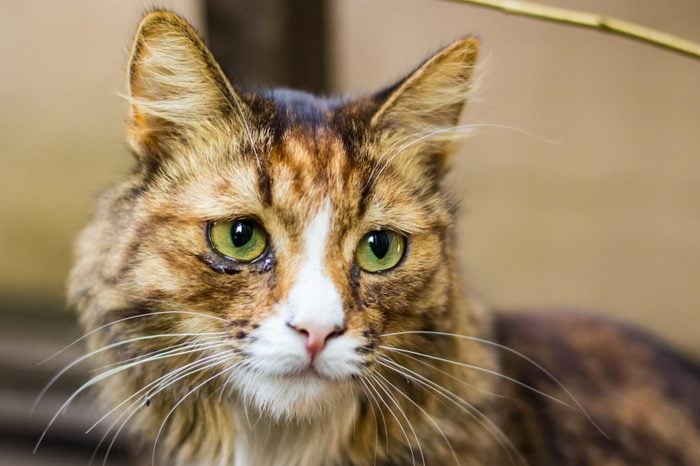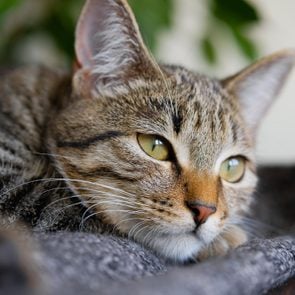Can Cats Cry?
Updated: Nov. 06, 2023

Anyone who has ever noticed tears in their cat's eyes has probably wondered, "Can cats cry?" Read on to find out the answer.
If you’ve ever seen your cat with what looks like tears in their eyes, you may think your cat is sad or depressed. Humans have a tendency to anthropomorphize and attribute our emotions to animals; it’s easy to assume a cat is upset when she has tears in her eyes. However, that’s not the case. Cat crying is not a communicative behavior like purring, meowing, or chirping. Unlike humans, who cry when feeling sad, our feline friends do not shed emotional tears. So why do cats cry?
Can cats cry tears?
The short answer is yes, cats’ tear ducts function the same way humans’ tear ducts do, but they don’t cry emotional tears from sadness or pain. While cats do “cry out in the sense that they may vocalize (meow, yowl, etc.) in an attempt to communicate or express some form of emotion,” explains Michelle Bourjaily, DVM, a veterinarian at Small Door Veterinary in New York City, there is no evidence to suggest that they produce tears when they are sad. Instead, use these signs to know if your cat is depressed.
Top reasons why your cat is crying
If your cat is not crying from pain or sadness, then you may wonder, “Why does my cat cry tears?” Cats actually produce tears in response to illnesses or injuries, Dr. Bourjaily explains. A cat with tears streaming down her furry face is most likely experiencing discomfort in her eyes due to an underlying condition. These include:
-
Allergies. Just like humans, cats can be allergic to environmental factors such as dust, pollen, and mold. They may also be allergic to certain foods, cigarette smoke, perfume, and chemicals in cleaning products. Allergy symptoms include sneezing, itching, and/or tearing up. Pet parents can alleviate allergies in cats by using a dust-free cat litter, bathing the cat to relieve itching, keeping the home clean of any dust or dirt, washing the cat’s bedding regularly, and feeding them a healthy diet.
-
Eye infection. Cats can catch bacterial and viral eye infections when they come into contact with other felines suffering from an infection. Kittens have naturally weakened immune systems and are more prone to eye infections. Trauma to the eye, either from something sharp or during a fight with another cat, can also cause eye infections. If you notice a clear, green, or yellow discharge coming from your cat’s eyes, along with a red eye, inflamed eyelid, or excessive winking, take her to the veterinarian for proper diagnosis and treatment.
-
Cat flu. Cats may exhibit teary eyes when they have an upper respiratory infection, also known as cat flu. It is most commonly caused by infection with feline calicivirus or feline herpesvirus. Other signs of cat flu include lethargy, sneezing, nasal discharge, fever, and lack of appetite. Similar to humans, there is no cure for the virus, so the veterinarian may prescribe eye drops, pain medication, antiviral medication, and antibiotics to manage the flu.
-
Glaucoma. This disease of the eye is caused by inadequate drainage of aqueous fluid (the clear liquid fluid in between the lens and the cornea), resulting from either an anatomical abnormality or injury to the eye. Partially closed eyes, squinting or rubbing of the eye, physical swelling or bulging of the eyeball, cloudy eyes, and watery discharge can be signs of glaucoma in cats. If you notice any of these symptoms, bring your cat to the vet immediately.
-
Corneal ulcers. Ulcers can lead to excessive tear production in addition to mucous discharge. If you notice your feline squinting, blinking, rubbing their eyes with their paws, cloudiness, or red eyes, bring them to the vet.
If you notice out-of-the-ordinary behavior, excessive vocalizations, or tear production, bring your cat to the veterinarian to find out the underlying causes and get them any necessary treatment.
Sources:
- Michelle Bourjaily, DVM at Small Door Veterinary



